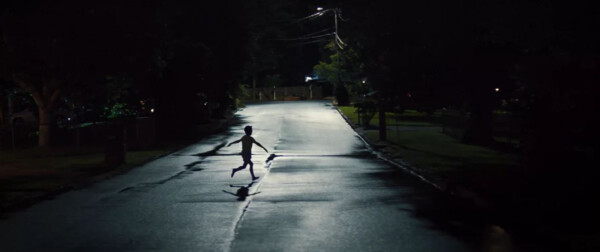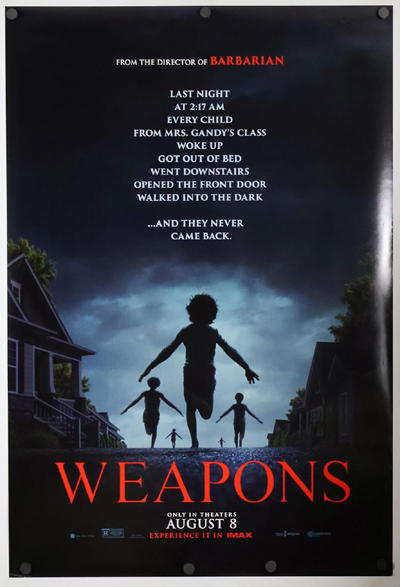Mladen and Del review ‘Weapons’

Image courtesy of Warner Bros. Pictures.
“Weapons” Starring Julie Garner as Justine, Amy Madigan as Gladys, Cary Christopher as Alex, Josh Brolin as Archer, Benedict Wong as Marcus, and others. Directed by Zach Cregger. 2 hours, 8 minutes. Rated R. Theatrical release.
Plot summary: A town is rent asunder when 17 of its children disappear, all from the same elementary school classroom. A teacher, a parent, a cop, a druggie, and a principal are enveloped by strange happenings as the saga of the missing kids devolves.
Spoilers: None
Mladen’s take
“Weapons” is a maybe. Maybe the recently released film is a horror flick. Maybe it’s a thriller. Maybe “Weapons” is slasher-y. Maybe it’s a good movie. And, maybe, I’ll never again see a film that Del recommends.
Yet, somehow, for some reason, the film has me bewitched. It’s the score. Every bit of music is matched perfectly to the scene it depicts. I’m telling you, no matter the combination of floating electronica or the talent of real musicians playing real instruments, the score made the movie’s etherealness palpable. I heard the eeriness, not as a complement to what was happening on the screen, but as its own story. As an aside, dear reader, a film’s score and its soundtrack are different animals. In this case, the soundtrack is sufficient.

What other recent movie scores accomplish the feat of making their films as aurally vibrant as their pictures? “Guns Akimbo.” “Dune.” “Blade Runner 2049.” “Ad Astra.” If you’re a streamer, listen to the soundtrack for “The Swarm.” Magnificent.
“Weapons” secondary merits are fairly abundant, too. The film is a slow burn that has you wondering what comes next. Also done well is the way the director blends “chapters,” each dedicated to one of our central characters, into a complete story with, of course, a climatic ending that brings all of them together. The way the director tells the story, as connected vignettes, was helped by very good acting. All the characters were well developed and both likable and unlikable.
The trouble with “Weapons?” The first had nothing to do with the film – I bought Del’s ticket to reciprocate a measly favor he did for me – but the others do.
I dislike movies where children are in peril or victimized or evil doers, even if they had no say in what they are doing. “Weapons” is that from beginning to end. It’s OK if high schoolers or young adults get whacked. In movies, as in life, they’re useless. But kids, “The Exorcist,” “The Omen”, “Children of the Corn,” come one. And, frankly, the ending ain’t all that cheerful, either.
What can I say? Depending on your taste or distaste, you’ll enjoy the movie or you won’t. For me, “Weapons” is a B-. I just don’t like seeing children in jeopardy, though I sure as hell adore the soundtrack that forced me to like a type of film I would normally disparage.
Del’s take
“Measly” favor my backside, Mladen. I figure you owe me an ADU in your back yard, maybe a Bentley. But I’ll agree with your B- grade of “Weapons” but not for the same reasons. Hear me out.
NPR says “Weapons” is a “terrific and terrifying movie.” No, it isn’t. It’s an OK movie with occasional moments of real tension, but as the curtain falls you’ll be asking yourself if it was worth the fuss.

I do appreciate the way the story was put together. As Mladen said, it’s divided into “chapters,” each one told from a different character’s viewpoint, and the chapters overlap, which at times explains inexplicable events from preceding chapters. Its structure reminded me of a Christopher Nolan movie.
The evolving inexplicabilities were more puzzling than frightening. I’ve seen that done effectively – the vastly underrated “The Crazies” springs first to mind. And that’s the problem with “Weapons.” It’s pitched as a horror movie but for me it wasn’t scary, and that’s a shame because the trailers were actually very creepy. It was over-the-top gory but I don’t conflate blood with tension. If you’d like to watch a REAL scary movie check out “The Innocents” on YouTube, with Deborah Kerr. THAT movie is terrifying, and not one skull was crushed in the process although Mladen would hate it because again, children are placed in peril.
I wasn’t as sold on the soundtrack as Mladen. It followed the modern sensibility of using music you don’t normally associate with a horror movie, and in my opinion it didn’t amplify the sense of foreboding, which I thought was the purpose of a horror movie soundtrack. They did include one very cool George Harrison song I’d never heard. I’ll be looking that up and adding it to my YouTube music playlist.
Quite a few of the characters were unlikeable. The lead viewpoint character, Julie Garner’s Justine, was a quarrelsome, argumentative alcoholic who helped her ex cheat on his present girlfriend. Josh Brolin’s Archer was an enraged finger-pointer in the MAGAt style, and Benedict Wong was an appeaser with questionable taste in lunch (Six hotdogs and a bowl of Cheetohs? C’mon!). The only real sympathetic character was the little boy, Alex (Cary Christopher), who just begged for a responsible adult to swoop in and rescue him from his horrible situation.
Amy Madigan was splendid as Gladys. I didn’t recognize her. I’ve never seen her in a role like that and she nailed it. Kudos … and maybe an Oscar nom?
But alas, not scary. At the movie’s climax people in the audience were laughing, for good reason. Events bordered on comical, and it wasn’t the intentional humor relief necessary to keep the audience invested in a scary story.
So yeah, Mladen, a B- for “Weapons.” Not a bad movie but not a scary Spooky Season movie either. I’ll save my shivers for “The Conjuring.”
Mladen Rudman is a former journalist and technical writer. Del Stone Jr. is a former journalist and writer.

Image by Flickr user Steve Bott. Creative Commons license. https://www.flickr.com/photos/stevebott/3580742598/
Have I talked about this subject before?
I may have talked about this subject before and if I have, please forgive me. They say that as you grow older, your memory is the second thing to go. I don’t remember what the first is.
At any rate, I’ve noticed that the people who leave nasty comments on my posts all seem to have a number of similar characteristics. This would be among the small pool who actually post photos of themselves in their profiles, because in many cases their profile photo is simply an empty placeholder, or a photo of a pickup truck, a hound dog or a burning cross.
But among those who actually do post an image of themselves I’ve noticed something unusual.
They all look like me.
That’s a horrifying thought, isn’t it? But it’s true, they all look like me. They’re all the same race, gender, age (give or take 10 years), and they’ve all got that Q-Tip stuff growing on the top of their head.
There are some noticeable differences, however. Their faces are ruddy, like a steam pipe about to explode. The capillaries in their noses are herniated, probably from alcohol abuse or sniffing the pharmaceutical of their choice. Their political and sexual orientations are 180 degrees opposite of mine. I care about people. They care about money. I care about the future. They care about the past.
But probably the biggest difference between them and me is that they all seem angry. Honest to God, they look like the before photo in an ad for Dulcolax. And I can’t figure out what the hell they’re so mad about. They’ve had the best of everything – the best education, the best jobs, they make the most money, and they’ve had the most opportunities. What are they so pissed-off about?
I’ve decided it’s because they’ve been told people like me are trying to take away their rights. Fox News, OAN, Newsmax, and similar “news” sites have been busy making money by scaring them into thinking I’m coming for their rights.
I have one of those magnetic stickers on the back of my car that reads: Equal rights for others doesn’t mean fewer rights for you. It’s not pie.
I would encourage my older, white, male antagonists to sit back, relax, and take a load off. Nobody’s coming for your rights. Allowing us to have the same rights as you doesn’t mean you lose anything.
As the sticker says: It’s not pie.
About the author:
Del Stone Jr. is a professional fiction writer. He is known primarily for his work in the contemporary dark fiction field, but has also published science fiction and contemporary fantasy. Stone’s stories, poetry and scripts have appeared in publications such as Amazing Stories, Eldritch Tales, and Bantam-Spectra’s Full Spectrum. His short fiction has been published in The Year’s Best Horror Stories XXII; Alfred Hitchcock’s Mystery Magazine; the Pocket Books anthology More Phobias; the Barnes & Noble anthologies 100 Wicked Little Witch Stories, Horrors! 365 Scary Stories, and 100 Astounding Little Alien Stories; the HWA anthology Psychos; and other short fiction venues, like Blood Muse, Live Without a Net, Zombiesque and Sex Macabre. Stone’s comic book debut was in the Clive Barker series of books, Hellraiser, published by Marvel/Epic and reprinted in The Best of Hellraiser anthology. He has also published stories in Penthouse Comix, and worked with artist Dave Dorman on many projects, including the illustrated novella “Roadkill,” a short story for the Andrew Vachss anthology Underground from Dark Horse, an ashcan titled “December” for Hero Illustrated, and several of Dorman’s Wasted Lands novellas and comics, such as Rail from Image and “The Uninvited.” Stone’s novel, Dead Heat, won the 1996 International Horror Guild’s award for best first novel and was a runner-up for the Bram Stoker Award. Stone has also been a finalist for the IHG award for short fiction, the British Fantasy Award for best novella, and a semifinalist for the Nebula and Writers of the Future awards. His stories have appeared in anthologies that have won the Bram Stoker Award and the World Fantasy Award. Two of his works were optioned for film, the novella “Black Tide” and short story “Crisis Line.”
Stone recently retired after a 41-year career in journalism. He won numerous awards for his work, and in 1986 was named Florida’s best columnist in his circulation division by the Florida Society of Newspaper Editors. In 2001 he received an honorable mention from the National Lesbian and Gay Journalists Association for his essay “When Freedom of Speech Ends” and in 2003 he was voted Best of the Best in the category of columnists by Emerald Coast Magazine. He participated in book signings and awareness campaigns, and was a guest on local television and radio programs.
As an addendum, Stone is single, kills tomatoes and morning glories with ruthless efficiency, once tied the stem of a cocktail cherry in a knot with his tongue, and carries a permanent scar on his chest after having been shot with a paintball gun. He’s in his 60s as of this writing but doesn’t look a day over 94.
Contact Del at [email protected]. He is also on Facebook, twitter, Pinterest, tumblr, TikTok, and Instagram. Visit his website at delstonejr.com .

Gallup just came out with a new poll of the most popular figures in the world opposed to the most unpopular figures in the world [ and before you ask, no, I don’t know why Vladimir Putin isn’t on the list ] and I wanted to read the results to you because they amuse me.
These are the most popular:
5. Alexandria Ocasio Cortez, with a ranking of negative 4 percentage points.
4. Emmanuel Macron of France, with a ranking of negative 1 percentage points.
3. Bernie Sanders, with a positive ranking of 11 percentage points.
2. Volodymyr Zelenskyy with a positive rating of 18 percentage points.
1. The most popular figure in the world right now is Pope Leo XIV, with a positive ranking of 46 percentage points.
Now for the most unpopular:
5. With a ranking of negative 12 is that drunk, Pete Hegseth. There must be a lot of alcoholics out there to rate him that high.
4. A tie between little Marco Rubio and …
3. Donald Trump, with a negative ranking of 16 percentage points. I don’t understand why Rubio is disliked to that extent, or that Trump is liked that much.
2. With a rating of negative 23 is Benjamin Netanyahu of Israel.
1. The most unpopular person in the world right now is Elon Musk with a negative 28 percentage point ranking.
Those are the most popular vs. the most unpopular personalities in the world right now according to Gallup. You’ll notice that not one of the five most popular are involved in the Trump regime, but four of the five most unpopular are either Trump himself, members of his regime or people who are affiliated with his regime.
Voters, take note.
About the author:
Del Stone Jr. is a professional fiction writer. He is known primarily for his work in the contemporary dark fiction field, but has also published science fiction and contemporary fantasy. Stone’s stories, poetry and scripts have appeared in publications such as Amazing Stories, Eldritch Tales, and Bantam-Spectra’s Full Spectrum. His short fiction has been published in The Year’s Best Horror Stories XXII; Alfred Hitchcock’s Mystery Magazine; the Pocket Books anthology More Phobias; the Barnes & Noble anthologies 100 Wicked Little Witch Stories, Horrors! 365 Scary Stories, and 100 Astounding Little Alien Stories; the HWA anthology Psychos; and other short fiction venues, like Blood Muse, Live Without a Net, Zombiesque and Sex Macabre. Stone’s comic book debut was in the Clive Barker series of books, Hellraiser, published by Marvel/Epic and reprinted in The Best of Hellraiser anthology. He has also published stories in Penthouse Comix, and worked with artist Dave Dorman on many projects, including the illustrated novella “Roadkill,” a short story for the Andrew Vachss anthology Underground from Dark Horse, an ashcan titled “December” for Hero Illustrated, and several of Dorman’s Wasted Lands novellas and comics, such as Rail from Image and “The Uninvited.” Stone’s novel, Dead Heat, won the 1996 International Horror Guild’s award for best first novel and was a runner-up for the Bram Stoker Award. Stone has also been a finalist for the IHG award for short fiction, the British Fantasy Award for best novella, and a semifinalist for the Nebula and Writers of the Future awards. His stories have appeared in anthologies that have won the Bram Stoker Award and the World Fantasy Award. Two of his works were optioned for film, the novella “Black Tide” and short story “Crisis Line.”
Stone recently retired after a 41-year career in journalism. He won numerous awards for his work, and in 1986 was named Florida’s best columnist in his circulation division by the Florida Society of Newspaper Editors. In 2001 he received an honorable mention from the National Lesbian and Gay Journalists Association for his essay “When Freedom of Speech Ends” and in 2003 he was voted Best of the Best in the category of columnists by Emerald Coast Magazine. He participated in book signings and awareness campaigns, and was a guest on local television and radio programs.
As an addendum, Stone is single, kills tomatoes and morning glories with ruthless efficiency, once tied the stem of a cocktail cherry in a knot with his tongue, and carries a permanent scar on his chest after having been shot with a paintball gun. He’s in his 60s as of this writing but doesn’t look a day over 94.
Contact Del at [email protected]. He is also on Facebook, twitter, Pinterest, tumblr, TikTok, and Instagram. Visit his website at delstonejr.com .
I run into two kinds of gay people online who drive me BONKERS!
Grrr!
The first is the kind who say, “Ugh! Politics are icky! I don’t want to get involved.”

I hate to say it but their existence has already been politicized, whether they like it or not. If they don’t get involved, they’re not going to end up at the back of the bus. They’re going to end up UNDER the bus.
The second group are the ones who have decided to cozy up to their oppressors. They’ll say things like, “I’m just living my fat dumb happy gay life and nobody’s bothering me.”
That’s because they’re solipsists. They’re so utterly and irredeemably self-absorbed they can’t see anything happening around them. They seem to think if everything’s OK for them then it must be OK for everyone else, too. They got the “dumb” part right, anyway.
What a life.
Or they’ll say, “What rights have YOU lost?”
Honey, there ain’t a video long enough to list all the ways this regime threatens the LGBTQ community, but I’ll mention one thing because I think it’s the worst thing they’ve done.
They’ve Made America HATE Again.
You know I’m telling the truth. You’ve seen it yourself, and I’m not just talking about the LGBTQ community. I’m talking about ANYBODY who isn’t white, male, Republican and so-called Christian.
You’ve seen the racial attacks in videos online. You’ve seen the guys pouring out of rental trucks and marching down the street wearing their swastika armbands. You’ve seen the attacks on gay people, a fact supported by crime stats from the FBI and the Southern Christian Poverty Law Center.
But hey, don’t take my word for it. The groups themselves say they’ve been emboldened by the current regime to come out of their dark closets and parade their hate for all the world to see.
If you can’t see that, it’s because you don’t want to see it. You’re deliberately averting your gaze to preserve your reprehensible identity.
And you know what? I have no use for you.
You’re a traitor to your community, and you’re a traitor to your country.
About the author:
Del Stone Jr. is a professional fiction writer. He is known primarily for his work in the contemporary dark fiction field, but has also published science fiction and contemporary fantasy. Stone’s stories, poetry and scripts have appeared in publications such as Amazing Stories, Eldritch Tales, and Bantam-Spectra’s Full Spectrum. His short fiction has been published in The Year’s Best Horror Stories XXII; Alfred Hitchcock’s Mystery Magazine; the Pocket Books anthology More Phobias; the Barnes & Noble anthologies 100 Wicked Little Witch Stories, Horrors! 365 Scary Stories, and 100 Astounding Little Alien Stories; the HWA anthology Psychos; and other short fiction venues, like Blood Muse, Live Without a Net, Zombiesque and Sex Macabre. Stone’s comic book debut was in the Clive Barker series of books, Hellraiser, published by Marvel/Epic and reprinted in The Best of Hellraiser anthology. He has also published stories in Penthouse Comix, and worked with artist Dave Dorman on many projects, including the illustrated novella “Roadkill,” a short story for the Andrew Vachss anthology Underground from Dark Horse, an ashcan titled “December” for Hero Illustrated, and several of Dorman’s Wasted Lands novellas and comics, such as Rail from Image and “The Uninvited.” Stone’s novel, Dead Heat, won the 1996 International Horror Guild’s award for best first novel and was a runner-up for the Bram Stoker Award. Stone has also been a finalist for the IHG award for short fiction, the British Fantasy Award for best novella, and a semifinalist for the Nebula and Writers of the Future awards. His stories have appeared in anthologies that have won the Bram Stoker Award and the World Fantasy Award. Two of his works were optioned for film, the novella “Black Tide” and short story “Crisis Line.”
Stone recently retired after a 41-year career in journalism. He won numerous awards for his work, and in 1986 was named Florida’s best columnist in his circulation division by the Florida Society of Newspaper Editors. In 2001 he received an honorable mention from the National Lesbian and Gay Journalists Association for his essay “When Freedom of Speech Ends” and in 2003 he was voted Best of the Best in the category of columnists by Emerald Coast Magazine. He participated in book signings and awareness campaigns, and was a guest on local television and radio programs.
As an addendum, Stone is single, kills tomatoes and morning glories with ruthless efficiency, once tied the stem of a cocktail cherry in a knot with his tongue, and carries a permanent scar on his chest after having been shot with a paintball gun. He’s in his 60s as of this writing but doesn’t look a day over 94.
Contact Del at [email protected]. He is also on Facebook, twitter, Pinterest, tumblr, TikTok, and Instagram. Visit his website at delstonejr.com .

Image courtesy of Paramount Pictures.
“The Naked Gun” Starring Liam Neeson as Frank Drebin Jr., Pamela Anderson as Beth Davenport, Paul Walter Hauser as Ed Hocken Jr., Danny Huston as Richard Cane CCH Pounder as Chief Davis. Directed by Akiva Schaffer. 1 hour, 25 minutes. Rated PG-13. Theatrical release.
Plot synopsis: The son of legendary police detective Frank Drebin must figure out who murdered a software engineer and simultaneously prevent the closure of Police Squad.
Spoilers: Some.
Del’s take
No matter WHAT Mopey Mladen writes in his review of “The Naked Gun,” know this: He giggled throughout the movie, from the opening bank heist scene to the closing credits where the on-set salad dressings were revealed – Russian, French, Italian and vinaigrette.
That’s because “The Naked Gun” is a hilarious movie – vulgar, profane, childish, all of those things, but funny as hell and a needed respite from the depressing comedy of errors playing across the nightly news these days. Liam Neeson is a worthy successor to Leslie Nielsen as he eats guns, swills bottomless cups of coffee and navigates his way through a steamy threesome with Pamela Anderson and a … er … snowman?
“The Naked Gun” captures the manic and absurd slapstick of the first “Naked Gun” and reprises several of the gags featured in that movie (the tear-away suit, for instance). In fact, Nielsen shows up in the 2025 “Naked Gun,” kinda sorta, as does another of the 1988 film’s cast, O.J. Simpson. (I told you it was vulgar.) Also spotted: Dave Bautista and Weird Al Yankovic. No sign of Priscilla Presley.
I’ve long been a fan of Three Stooges-style physical comedy and “Naked Gun,” just as its predecessor, does not disappoint. Neeson uses the “body” of a bank robber to shield himself from the bullets of other bank robbers, rips the arms off a bad guy then uses said arms to bitch slap said bad guy, and tears down half the police station after he forgets to unhook the charger and drives off in an electric car. All that’s missing is the hollow coconut conking sound.
But the humor operates on different levels. Neeson’s performance is a teasing homage to his tough-guy roles in movies like “Taken” and “Non-Stop.” And the wild double entendres are enough to keep any linguist’s eyes batting back and forth as if he or she was watching the spoken equivalent of the Wimbledon finals. It carries into the closing theme song, delivered in a goofy lounge lizard style, and even the credits, with lots and lots of Easter eggs for the discerning eye. Speaking of which, there’s a short Easter egg at the very end, so be sure to stick it out until the lights come up.
Akiva Schaffer brings his comedy chops to the direction (Saturday Night Live, “Pop Star: Never Stop, Never Stopping”) and joins Dan Gregor and Doug Mand in writing the clever, clever script:
“It says here you served 20 years for man’s laughter.”
“You mean ‘manslaughter’?”
“Must have been quite the joke.”
Ha ha ha ha ha ha!
My only complaint: the snowman scene. It was over-the-top weird.
After “The Naked Gun” I can say with complete confidence that I will never, EVER be able to spy on a man, woman and a dog with Star Wars-style infrared binoculars and be the same person again. EVER.
Grade: A-.
Mladen’s take
Is it possible for a comedy movie to have too much comedy? Yes, I say to thee. The recently released “The Naked Gun” is an example.
I’ll partition the film into thirds (roughly) to make my case. I do this, in part, because Del used only two-thirds of his brain to write his review.

The first portion of the first third of “The Naked Gun” is very funny. It riffs the “Mission Impossible” use of impossible physical disguises to fool the enemy. The biology of reflex or capacity to absorb physical abuse in action movies such as the immortal John Wicks – or, really, any film where the good guy or gal seeks revenge, runs after getting set up for a crime he or she didn’t commit, or chases commies, terrorists, or rogue billionaires – are also targets.
Then, the satire and slapstick morphs past silliness. You expect silliness in an homage to the original “The Naked Gun” but the new “The Naked Gun” often crash lands on the helipad of ridiculousness. Del mentions the Snowman. Well, Del, what about the O
owl, huh? There’s word play causing misunderstanding. There’s word play dipped as sexual innuendo. And, there’s word play that shows dumbness. And, it’s happening all the time.
The second third of the movie has a funny run exploiting the peril of perspective. A bad guy uses a pair of infrared binoculars to spy on Frank Drebin Jr. (Liam Neeson) and Beth Davenport (Pamela Anderson) making dinner and taking care of a dog. One moment you see what the peeping Tom perp is seeing through his high-tech spyglasses and the next what is actually happening in Drebin’s apartment.
The third third of “The Naked Gun” is funny. The last stretch of the last third of the movie takes a shot at the self-delusional hedonism of toxic masculinity that weaves its way through the film as its plot. The principal bad guy wants to return mankind to Hobbs’s state of nature but has never experienced violence and combat himself. That’s amusingly portrayed – the ideal of only the fittest surviving though the tech billionaire ain’t nowhere to being the fittest – at the end of the film.
The problem with “The Naked Gun”? Practically every scene has some sort of verbal or physical shtick happening. For me, if everything is shtick, then, eventually, nothing is funny anymore. That was not the case for Del. He giggled, chuckled, or almost laughed from the beginning to the end of the movie. Initially, I empathized with crotchety Del. The movie started out funny. Then, I sympathized with Del. The movie was trying to sustain its daffiness and I couldn’t blame Del for enjoying it. But, as the movie progressed, it became predictable and a tad tiresome.
“The Naked Gun” is a B, maybe a B-. Sometimes it just feels that the writers were throwing ideas at the wall to see if they would stick as comedy. Here and there, they missed the wall altogether. There’s no reason to see the film in a theater. The humor is perfectly fit for the small screen and the action not so boisterous or spectacular that it demands big speakers.
Mladen Rudman is a former journalist and technical writer. Del Stone Jr. is a former journalist and writer.

Image by Flickr user Narih Lee. Creative Commons license. https://www.flickr.com/people/40461587@N07
I had a very unhappy MAGAt leave a comment on one of my videos that read:
“We will find you.”
I guess he thought he was Liam Neeson in “Taken.” I meant to ask if he had a particular set of skills, but I wasn’t thinking.
I don’t take these kinds of comments lightly, but at the same time I don’t lose a lot of sleep over them. I worked for a newspaper for decades. We got those kinds of threats from the public on a regular basis.
I had a woman tell me she was going to come down to the office with a pew-pew and unalive me. That earned her a visit from law enforcement.
I had a police officer say he was going to come down to the office and “beat my F-A-6-6-O-T ass” because he didn’t like a column I had written. He too received a visit from law enforcement.
I was out jogging one day when a man driving a van passed by, recognized me from the newspaper, pulled off the road ahead of me, blocking my path, and got out of his van and screamed and yelled at me about another column I’d written.
And one morning I found a note on my front door that had been made from letters cut from a magazine and glued to a piece of paper. The note said I would turn up missing.
I had my tires slashed at the office – twice. One time somebody smashed into the side of my car while I was inside the office working. Another time somebody crushed the front fender of my car while I was inside.
I have been called every slur, every epithet, every curse word you can image – but I’m still here!
Obviously I hope none of these bad things come to pass, because at age 70 my ability to defend myself isn’t what it used to be, and it was never that great to begin with. I’ll give it the old college try.
But I would remind these folks that assaulting a senior citizen is a felony, and if there’s a gay component to the assault then it becomes a hate crime, which is also a felony. Is it really worth spending the rest of your life in prison just to shut somebody up on social media?
It was only a few years ago that people were fond of saying, “I may not agree with your opinion but I will defend to the end your right to express it.” These days the saying seems to be, “Your opinion better agree with mine because if you don’t, I’m going to silence you.”
That may be the way they do things in Russia, China, Iran or North Korea, but that is mostly definitely NOT the American way.
About the author:
Del Stone Jr. is a professional fiction writer. He is known primarily for his work in the contemporary dark fiction field, but has also published science fiction and contemporary fantasy. Stone’s stories, poetry and scripts have appeared in publications such as Amazing Stories, Eldritch Tales, and Bantam-Spectra’s Full Spectrum. His short fiction has been published in The Year’s Best Horror Stories XXII; Alfred Hitchcock’s Mystery Magazine; the Pocket Books anthology More Phobias; the Barnes & Noble anthologies 100 Wicked Little Witch Stories, Horrors! 365 Scary Stories, and 100 Astounding Little Alien Stories; the HWA anthology Psychos; and other short fiction venues, like Blood Muse, Live Without a Net, Zombiesque and Sex Macabre. Stone’s comic book debut was in the Clive Barker series of books, Hellraiser, published by Marvel/Epic and reprinted in The Best of Hellraiser anthology. He has also published stories in Penthouse Comix, and worked with artist Dave Dorman on many projects, including the illustrated novella “Roadkill,” a short story for the Andrew Vachss anthology Underground from Dark Horse, an ashcan titled “December” for Hero Illustrated, and several of Dorman’s Wasted Lands novellas and comics, such as Rail from Image and “The Uninvited.” Stone’s novel, Dead Heat, won the 1996 International Horror Guild’s award for best first novel and was a runner-up for the Bram Stoker Award. Stone has also been a finalist for the IHG award for short fiction, the British Fantasy Award for best novella, and a semifinalist for the Nebula and Writers of the Future awards. His stories have appeared in anthologies that have won the Bram Stoker Award and the World Fantasy Award. Two of his works were optioned for film, the novella “Black Tide” and short story “Crisis Line.”
Stone recently retired after a 41-year career in journalism. He won numerous awards for his work, and in 1986 was named Florida’s best columnist in his circulation division by the Florida Society of Newspaper Editors. In 2001 he received an honorable mention from the National Lesbian and Gay Journalists Association for his essay “When Freedom of Speech Ends” and in 2003 he was voted Best of the Best in the category of columnists by Emerald Coast Magazine. He participated in book signings and awareness campaigns, and was a guest on local television and radio programs.
As an addendum, Stone is single, kills tomatoes and morning glories with ruthless efficiency, once tied the stem of a cocktail cherry in a knot with his tongue, and carries a permanent scar on his chest after having been shot with a paintball gun. He’s in his 60s as of this writing but doesn’t look a day over 94.
Contact Del at [email protected]. He is also on Facebook, twitter, Pinterest, tumblr, TikTok, and Instagram. Visit his website at delstonejr.com .

Image from The Communist.
I suppose by now you’ve heard about yesterday’s awful jobs report.
Only 73,000 jobs were created in this country for the month of July. You usually want that number to be around 150,000. For context, the last full month that Joe Biden was president – December 2024 – the number of new jobs created in this country was 256,000.
Oh, for the good old days.
There’s more bad news. The job numbers for May and June had to be revised – downward. The number of new jobs created in this country for May was 19,000. Worse, the number of new jobs created in June was only 14,000.
That’s a statistical drop in the bucket. Any lower and we’d be flirting with negative job growth.
When Joe Biden was in office, the number of available positions in this country topped out at over 12 million. Today that number is below 8 million.
President Hoover was so unhappy with these numbers he fired the commissioner of the Bureau of Labor Statistics, Dr. Erika McEntarfer, which sent a clear to message to others who compile economic numbers: If the numbers are bad, LIE, because the emperor does not like being told he has no clothes.
At this juncture we have two distinctly different ways of looking at the world:
1. The Reality Viewpoint, which holds the jobs reports for May, June and July were truly and spectacularly shitty, and:
2. The Narnia Viewpoint, which holds the economy is roaring like a bonfire under the wise guidance of President Hoover … and the animals move their lips when they’re lying.
The reality is we are probably headed for a recession. Other numbers tend to support that conclusion.
Remember when President Hoover said he would not let the value of the dollar decline? Well, guess what: Since January, when President Hoover took office, the value of the dollar has declined 11 percent.
You know what isn’t down?
Inflation.
Yup, inflation rose to almost 3 percent last month. Economists say that with President Hoover’s on-again, off-again tariffs, inflation is bound to rise even more.
Ford and Stellantis both registered losses for the latest quarter. GM managed to eke out a profit but said its earnings were cut in half – by President Hoover’s tariffs.
The experts say the reason the economy hasn’t tanked before now is because businesses, anticipating President Hoover’s mismanagement, laid in a stash of inventory before the tariffs went into effect. But now those inventories are being depleted and we are having to shift from the Narnia worldview back to a sobering reality of higher prices and fewer jobs.
As for those MAGAts and ’bots bragging about all that tariff money coming into the government’s balance sheets, I would remind them that, OK, President Hoover increased their taxes, and now the government has more money to give to billionaires. They pay more for shit and the government has more money? That’s hardly the flex they think it is. It’s time for the MAGAts to wake up and face the world they’ve created.
Oh, and the stock market they’re always crowing about? Yeah, it lost 1.2 percent of its value yesterday.
Time to shift those stocks into bonds, because even Wall Street, as greedy and complicit as it is, must sometimes deal in reality.
About the author:
Del Stone Jr. is a professional fiction writer. He is known primarily for his work in the contemporary dark fiction field, but has also published science fiction and contemporary fantasy. Stone’s stories, poetry and scripts have appeared in publications such as Amazing Stories, Eldritch Tales, and Bantam-Spectra’s Full Spectrum. His short fiction has been published in The Year’s Best Horror Stories XXII; Alfred Hitchcock’s Mystery Magazine; the Pocket Books anthology More Phobias; the Barnes & Noble anthologies 100 Wicked Little Witch Stories, Horrors! 365 Scary Stories, and 100 Astounding Little Alien Stories; the HWA anthology Psychos; and other short fiction venues, like Blood Muse, Live Without a Net, Zombiesque and Sex Macabre. Stone’s comic book debut was in the Clive Barker series of books, Hellraiser, published by Marvel/Epic and reprinted in The Best of Hellraiser anthology. He has also published stories in Penthouse Comix, and worked with artist Dave Dorman on many projects, including the illustrated novella “Roadkill,” a short story for the Andrew Vachss anthology Underground from Dark Horse, an ashcan titled “December” for Hero Illustrated, and several of Dorman’s Wasted Lands novellas and comics, such as Rail from Image and “The Uninvited.” Stone’s novel, Dead Heat, won the 1996 International Horror Guild’s award for best first novel and was a runner-up for the Bram Stoker Award. Stone has also been a finalist for the IHG award for short fiction, the British Fantasy Award for best novella, and a semifinalist for the Nebula and Writers of the Future awards. His stories have appeared in anthologies that have won the Bram Stoker Award and the World Fantasy Award. Two of his works were optioned for film, the novella “Black Tide” and short story “Crisis Line.”
Stone recently retired after a 41-year career in journalism. He won numerous awards for his work, and in 1986 was named Florida’s best columnist in his circulation division by the Florida Society of Newspaper Editors. In 2001 he received an honorable mention from the National Lesbian and Gay Journalists Association for his essay “When Freedom of Speech Ends” and in 2003 he was voted Best of the Best in the category of columnists by Emerald Coast Magazine. He participated in book signings and awareness campaigns, and was a guest on local television and radio programs.
As an addendum, Stone is single, kills tomatoes and morning glories with ruthless efficiency, once tied the stem of a cocktail cherry in a knot with his tongue, and carries a permanent scar on his chest after having been shot with a paintball gun. He’s in his 60s as of this writing but doesn’t look a day over 94.
Contact Del at [email protected]. He is also on Facebook, twitter, Pinterest, tumblr, TikTok, and Instagram. Visit his website at delstonejr.com .

Image by DonkeyHote of flickr. Creative Commons license.
Hurricane Helene struck the Big Bend area of Florida in 2024 with winds of 140 mph. As the storm made its way through Georgia, the Carolinas and Kentucky, it claimed the lives of 252 people and caused almost $80 billion in damages.
Days before the storm hit, Congress had a chance to attach a supplemental disaster relief bill to a government funding measure that would have helped FEMA quickly respond to the hurricane. Instead of remaining in Washington, D.C., to make sure FEMA got those funds, Florida Sen. Rick Scott skipped the vote and left town – partly because of the approaching hurricane!
That disaster relief supplement was not approved. What followed was a chorus of criticism, primarily from MAGAts, about FEMA’s response to the storm, a response that had been hobbled by money-grubbing Republicans.
Meanwhile, Scott recently voted against a bill that would bar lawmakers, the vice president and president from trading stocks while serving in office. “How many of you don’t want to make money?” Scott asked while speaking against the measure.
The bill eventually passed, but it isn’t known if it’ll be taken up by the Senate at a later date.
It should be obvious to even the MAGAts that Rick Scott doesn’t give a damn about Floridians. What Rick Scott cares about is making MONEY.
In 2018 when Rick Scott became a U.S. senator, his net worth was estimated at $259.66, according to Open Secrets. As of 2025 his net worth, according to Quiver Quantitative, is $553.89 million. That’s a 113 percent increase in seven years, all on a paycheck of $174,000 per year. Not bad for a “servant” of the people.
Rick Scott seems to have forgotten why he was elected to the Senate. He isn’t there to make money. He’s there to serve the people of Florida. If serving the people of Florida gets in the way of his making money, he needs to step aside and let somebody else take that job. It’s not too much to ask that these so-called “servants” refrain from using their positions of trust to get filthy, stinking rich.
I don’t understand why people aren’t mad about this. Why aren’t people furious?
By the way, Rick Scott is up for re-election in 2026.
For the love of God, Floridians, do the right thing.
About the author:
Del Stone Jr. is a professional fiction writer. He is known primarily for his work in the contemporary dark fiction field, but has also published science fiction and contemporary fantasy. Stone’s stories, poetry and scripts have appeared in publications such as Amazing Stories, Eldritch Tales, and Bantam-Spectra’s Full Spectrum. His short fiction has been published in The Year’s Best Horror Stories XXII; Alfred Hitchcock’s Mystery Magazine; the Pocket Books anthology More Phobias; the Barnes & Noble anthologies 100 Wicked Little Witch Stories, Horrors! 365 Scary Stories, and 100 Astounding Little Alien Stories; the HWA anthology Psychos; and other short fiction venues, like Blood Muse, Live Without a Net, Zombiesque and Sex Macabre. Stone’s comic book debut was in the Clive Barker series of books, Hellraiser, published by Marvel/Epic and reprinted in The Best of Hellraiser anthology. He has also published stories in Penthouse Comix, and worked with artist Dave Dorman on many projects, including the illustrated novella “Roadkill,” a short story for the Andrew Vachss anthology Underground from Dark Horse, an ashcan titled “December” for Hero Illustrated, and several of Dorman’s Wasted Lands novellas and comics, such as Rail from Image and “The Uninvited.” Stone’s novel, Dead Heat, won the 1996 International Horror Guild’s award for best first novel and was a runner-up for the Bram Stoker Award. Stone has also been a finalist for the IHG award for short fiction, the British Fantasy Award for best novella, and a semifinalist for the Nebula and Writers of the Future awards. His stories have appeared in anthologies that have won the Bram Stoker Award and the World Fantasy Award. Two of his works were optioned for film, the novella “Black Tide” and short story “Crisis Line.”
Stone recently retired after a 41-year career in journalism. He won numerous awards for his work, and in 1986 was named Florida’s best columnist in his circulation division by the Florida Society of Newspaper Editors. In 2001 he received an honorable mention from the National Lesbian and Gay Journalists Association for his essay “When Freedom of Speech Ends” and in 2003 he was voted Best of the Best in the category of columnists by Emerald Coast Magazine. He participated in book signings and awareness campaigns, and was a guest on local television and radio programs.
As an addendum, Stone is single, kills tomatoes and morning glories with ruthless efficiency, once tied the stem of a cocktail cherry in a knot with his tongue, and carries a permanent scar on his chest after having been shot with a paintball gun. He’s in his 60s as of this writing but doesn’t look a day over 94.
Contact Del at [email protected]. He is also on Facebook, twitter, Pinterest, tumblr, TikTok, and Instagram. Visit his website at delstonejr.com .
I got a message from a fellow who asked if I could talk about things other than politics. He said the politics are getting old.
I told him I talk about politics for two reasons – No. 1 that, obviously, we’re having a moment in this country and it’s important to seize that moment and talk about politics now, while we still can.
The other reason is that when I talk about things other than politics I don’t get nearly the interaction and the engagement I get with a political topic.
However, I thought I would ask you guys.
About the author:
Del Stone Jr. is a professional fiction writer. He is known primarily for his work in the contemporary dark fiction field, but has also published science fiction and contemporary fantasy. Stone’s stories, poetry and scripts have appeared in publications such as Amazing Stories, Eldritch Tales, and Bantam-Spectra’s Full Spectrum. His short fiction has been published in The Year’s Best Horror Stories XXII; Alfred Hitchcock’s Mystery Magazine; the Pocket Books anthology More Phobias; the Barnes & Noble anthologies 100 Wicked Little Witch Stories, Horrors! 365 Scary Stories, and 100 Astounding Little Alien Stories; the HWA anthology Psychos; and other short fiction venues, like Blood Muse, Live Without a Net, Zombiesque and Sex Macabre. Stone’s comic book debut was in the Clive Barker series of books, Hellraiser, published by Marvel/Epic and reprinted in The Best of Hellraiser anthology. He has also published stories in Penthouse Comix, and worked with artist Dave Dorman on many projects, including the illustrated novella “Roadkill,” a short story for the Andrew Vachss anthology Underground from Dark Horse, an ashcan titled “December” for Hero Illustrated, and several of Dorman’s Wasted Lands novellas and comics, such as Rail from Image and “The Uninvited.” Stone’s novel, Dead Heat, won the 1996 International Horror Guild’s award for best first novel and was a runner-up for the Bram Stoker Award. Stone has also been a finalist for the IHG award for short fiction, the British Fantasy Award for best novella, and a semifinalist for the Nebula and Writers of the Future awards. His stories have appeared in anthologies that have won the Bram Stoker Award and the World Fantasy Award. Two of his works were optioned for film, the novella “Black Tide” and short story “Crisis Line.”
Stone recently retired after a 41-year career in journalism. He won numerous awards for his work, and in 1986 was named Florida’s best columnist in his circulation division by the Florida Society of Newspaper Editors. In 2001 he received an honorable mention from the National Lesbian and Gay Journalists Association for his essay “When Freedom of Speech Ends” and in 2003 he was voted Best of the Best in the category of columnists by Emerald Coast Magazine. He participated in book signings and awareness campaigns, and was a guest on local television and radio programs.
As an addendum, Stone is single, kills tomatoes and morning glories with ruthless efficiency, once tied the stem of a cocktail cherry in a knot with his tongue, and carries a permanent scar on his chest after having been shot with a paintball gun. He’s in his 60s as of this writing but doesn’t look a day over 94.
Contact Del at [email protected]. He is also on Facebook, twitter, Pinterest, tumblr, TikTok, and Instagram. Visit his website at delstonejr.com .
Would you rather I talk about things other than politics? Or maybe occasionally talk about something other than politics?
Leave me a comment and I’ll read them and take them to heart.